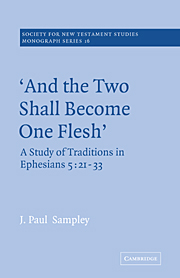Book contents
- Frontmatter
- Contents
- Dedication
- Preface
- Acknowledgments
- I Introduction of problem and perspective
- II Outline of the epistle to the Ephesians and the author's knowledge of his readers
- III Identification and study of traditional materials in 5: 21–33
- IV Three passages from the homologoumena especially related to 5: 21–33
- V Hermeneutical problems in 5: 31–2
- VI The movement of thought in 5: 21–33
- VII Detailed analysis of 5: 21–33
- VIII Concluding observations
- Bibliography
- Indexes (passages cited, authors, subjects, selected Greek words)
II - Outline of the epistle to the Ephesians and the author's knowledge of his readers
Published online by Cambridge University Press: 29 September 2009
- Frontmatter
- Contents
- Dedication
- Preface
- Acknowledgments
- I Introduction of problem and perspective
- II Outline of the epistle to the Ephesians and the author's knowledge of his readers
- III Identification and study of traditional materials in 5: 21–33
- IV Three passages from the homologoumena especially related to 5: 21–33
- V Hermeneutical problems in 5: 31–2
- VI The movement of thought in 5: 21–33
- VII Detailed analysis of 5: 21–33
- VIII Concluding observations
- Bibliography
- Indexes (passages cited, authors, subjects, selected Greek words)
Summary
In order to understand the place of the Haustafel in the epistle to the Ephesians, and in order to establish a context for the entire investigation, there follows an outline of the epistle.
Ephesians bears many of the formal characteristics of the epistolary style common to the homologoumena. There is the opening greeting (1: 1–2) that credits the letter to Paul. In 6: 23–4 there is the conventional benediction. In place of the customary thanksgiving found in five letters of the homologoumena immediately following the greeting, there is in Ephesians, as in 2 Corinthians (1: 3 ff.), a section that opens with the blessing of God the Father (1: 3 ff.). Within the body of the letter a division is made rather easy by the appearance of a doxology at the close of chapter 3 (3: 20–1). As in the homologoumena there is no absolute distinction between theological and ethical or didactic and hortatory sections. Throughout Ephesians these are interwoven.
The letter opens with the greeting ‘to the saints who are also faithful in Christ Jesus’ (1: 1–2). There follows the blessing and praise of God for his blessing received in and through Christ, his beloved, in accordance with God's plan and purpose (1: 3–14).
Structurally, 1: 15–2: 10 may be considered a unit because of its special relationship to Ps. 110.
- Type
- Chapter
- Information
- 'And The Two Shall Become One Flesh'A Study of Traditions in Ephesians 5: 21-33, pp. 6 - 15Publisher: Cambridge University PressPrint publication year: 1971



